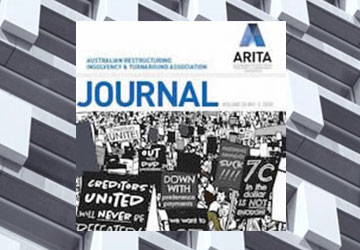Unfair preference claims and the set-off “defence”
Case Law Alert: Unfair preference claims and the set-off “defence” under section 553c (part 1 of 3)
The Section: Section 553C of the Corporations Act 2001 (Cth) (the “Act”) provides for a statutory set-off between an insolvent company and a party seeking to have a debt or claim admitted in the winding up. Provided that the creditor did not have notice of the company’s insolvency at the relevant time, the section is enlivened where there have been ‘mutual credits, mutual debts or other mutual dealings’ between the parties and allows for an account and set-off of sums due between them in respect of those mutual dealings, with only the balance of that account being admissible to proof against the company or payable to the company as the case may be.
The Case Law Development: The question of whether section 553C set-off is available as a “defence” to an unfair preference claim against a creditor has been the subject of ongoing debate and conflicting authority, but should shortly benefit from added certainty, with the Full Court of the Federal Court set to hand down a decision in the first substantive consideration of the issue by an appeal court.
In Gavin Morton as Liquidator of MJ Woodman Electrical Contractors Pty Ltd (in liquidation) v Metal Manufacturers Pty Ltd, the liquidator is pursuing the defendant for an unfair preference. By way of defence, the defendant points to its separate and admitted debt of a higher amount and seeks set-off under section 553C. Without this set-off, the defendant could be liable to pay to the liquidator the full amount of the unfair preference, and then seek payment of its debt in the ordinary course of the winding up (and on a pari passu basis with all other creditors).
Although a number of recent decisions have held that such a set-off is available to the defendant, this position has also come under strong criticism and has been the subject of conflicting academic and judicial commentary.
Presumably with a view to resolving this ongoing controversy, in MJ Woodman Electrical Contractorsthe Court has ordered that the application of set-off provisions be determined as a preliminary question and be reserved for consideration by the Full Court.
With Chief Justice Allsop, Justice Middleton and Justice Derrington presiding, the Full Court has now heard the parties’ argument in the action and is expected to hand down its decision soon.
The Questions To Be Answered: In deciding the application of section 553C to unfair preference claims, the Full Court was asked to consider the statutory history and purpose of the provisions (tracing back to the English Companies Act 1862), the structure of the Corporations Act 2001 (Cth), as well as recent authorities and academic commentary. By way of a high-level summary, the issues debated by the parties and the questions to be answered by the Full Court include:
- Mutuality: Is the section 553C requirement that there be “mutual” dealings between the parties satisfied when the unfair preference claim vests in, and is pursued by, the company’s liquidator, but the creditor is owed funds by the company itself? On the one hand, there is no “mutual” dealings between the company and the creditor because an order for repayment of an unfair preference does not become part of the general assets of the company and remains under the administration and control of the liquidator. On the other, on a substance-over-form analysis, the company may be construed to be the beneficial owner of any proceeds.
- Timing: Is the section 553C requirement that there be mutual claims before the relevant date satisfied in an unfair preference action? On the one hand, the preference provisions do not create any right of action or legal obligation until after liquidation. On the other, a preference claim could be construed as a contingent obligation to make a repayment, where the underlying facts or elements of the claim are capable of existence before the winding up.
- Statutory structure: Are the two sets of provisions (i.e. Part 5.6 set-off on the one hand and Part 5.7B unfair preference claims on the other) intended to have separate spheres of operation, or are unfair preference claims qualified by the set-off provisions?
- Statutory purpose: Would the statutory purpose of the preference regime be satisfied if set-off is permitted? If a creditor is allowed to retain some or all of an otherwise preferential payment by setting off their unsecured debt, with only some or none of that preferential payment then being returned to the pool available for distribution to all creditors, does it undermine the purpose of achieving “fairness” in an insolvency administration? Or is the “fairness” balance still properly struck when one takes into account that the creditor claims set-off for an additional and different debt (i.e. not the debt the subject of the unfair preference), and is “innocent” is claiming that set-off (i.e. not on notice of insolvency at the relevant time)?
Watch This Space: In Part 2 of this Case Law Alert, LCM will report on the Full Court’s decision as soon as it is delivered.




